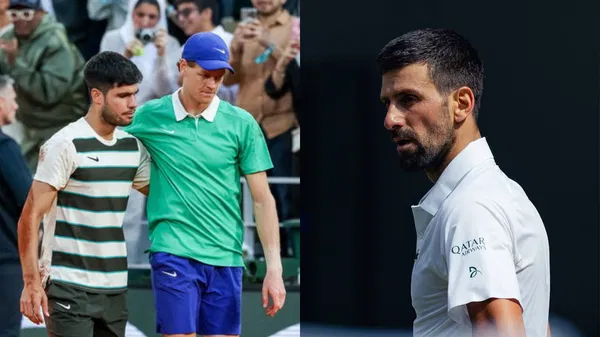 Here’s a full breakdown of the situation: what Djokovic said, why it matters, the reactions, and the broader contex.
Here’s a full breakdown of the situation: what Djokovic said, why it matters, the reactions, and the broader contex.
What Djokovic Actually Said
In Riyadh, ahead of an exhibition match (Six Kings Slam), Djokovic addressed speculation about retirement. He emphatically said he has no plans to retire anytime soon.
Asked if younger stars like Jannik Sinner and Carlos Alcaraz might force him into retirement, Djokovic responded: “I’m sorry to disappoint them — it’s just not happening.”
He cited veteran athletes like LeBron James, Cristiano Ronaldo, and Tom Brady as inspirations for his longevity — pointing out how they remain competitive at age 40+ and saying their example motivates him to keep going.
Djokovic acknowledged the challenges of aging — especially in long, best-of-five matches in Grand Slams — but maintained that he still feels capable of playing “at a high level” as long as his body allows it.
After his US Open semi‑final loss to Alcaraz, he admitted he “ran out of gas” after two sets and said that overcoming players like Alcaraz and Sinner in best-of-five formats is becoming “very difficult.”
He stopped short of full commitment to playing a full Grand Slam schedule in 2026, leaving some uncertainty about whether he will participate in all majors next year.
—
Why It’s Significant — What “Warning” Means Here
When media talk about Djokovic “warning” Sinner and Alcaraz, it’s more nuanced than a threat. It’s about assertion and positioning:
Djokovic is signaling that although new generations are dominant, he still considers himself a contender and won’t fade silently.
He’s rejecting the idea that these younger players will force him out of the game simply by their rise.
There’s psychological weight in such statements: in elite sport, confidence and aura matter. By projecting strength, Djokovic aims to preserve his competitive edge (in press and perhaps in head-to-head matchups).
He’s also setting expectations: acknowledging that matches are harder, physically, but insisting he’ll keep fighting — which frames any future loss not simply as decline, but as part of a continued struggle.
—
Reactions & Interpretation
Many commentators interpret Djokovic’s remarks as a mix of defiance and realism. While he refuses to retire, he’s not blind to the toll of age.
Some see this as a “passing of the guard” moment — but Djokovic is pushing back on that narrative. In a Vogue interview, he said transitions in sports are rarely “black and white” and he doesn’t see himself as done yet.
Analysts note his physical decline is more evident in Grand Slams, where matches are longer. Against younger, fitter rivals like Sinner and Alcaraz, the margin is narrowing.
—
Broader Context & What Comes Next
Recent head-to-heads: Djokovic has lost multiple Grand Slam semi‑finals to both Sinner and Alcaraz this year.
Physical condition & age: Djokovic has openly discussed the wear and tear on his body, admitting that playing full five-set matches is more challenging now.
Future plans uncertain: He’s positive about playing more, but cautious about committing to a full Slam calendar.
Exhibition vs. competitive stakes: While exhibitions like the Six Kings Slam generate headlines, they don’t perfectly reflect competitive pressure — but Djokovic’s statements there carry symbolic weight.
Legacy & motivation: Djokovic is clearly motivated to continue building on his legacy. He’s framed himself as a participant in tennis’s “rejuvenation,” wanting to stay a visible, active part of the sport’s evolution.